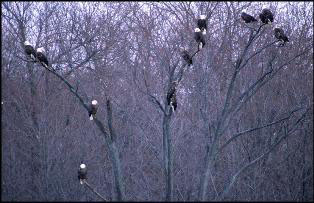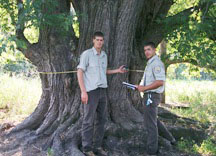Mississippi River Forestry
The Mississippi River floodplain forest is one of the largest contiguous stretches of floodplain forest habitat in the Midwest. The Wisconsin portion of the floodplain or bottomland forest covers many thousands of acres along the river.
Bottomland Forest provides critical habitat

American bald eagles use the bottomland forest bordering the Mississippi River for nesting and as daytime perch sites. The trees that are large enough to support several eagles at a time and offer good visibility of the river can attract large congregations during spring and fall migration periods.
The north to south orientation of this long stretch of forest provides a critical highway of habitat for waterbirds, raptors and songbirds as they move between their breeding grounds in the north and their wintering areas along the Gulf Coast or in South America. The bottomland forest also provides a home to a large variety of wildlife including amphibians, reptiles, mammals and birds such as warblers, wood ducks and hooded mergansers, red-shouldered hawks and bald eagles. It is an integral part of the river's ecology as the forest improves water quality and provides a place to temporarily store and move excess water during the spring thaw or following heavy rains.
Who owns the floodplain forest?
Bottomland forest is an important component of several state public properties located along the banks of the Mississippi River, including state parks, wildlife areas and state natural areas (including the Whitman Bottoms Floodplain Forest near Merrick State Park). However, much of the Mississippi River bottomland forest in Wisconsin is under federal ownership.
During the 1930s the U.S Army Corps of Engineers (USACE) purchased a large amount of land within the floodplain to build the nine-foot channel navigation project. While much of this land was permanently flooded, extensive tracts of floodplain forest remain above the normal pool level. Part of this forest resource is managed by the U.S. Fish and Wildlife Service as the Upper Mississippi River National Wildlife and Fish Refuge under a cooperative agreement with the USACE, in addition to other tracts of floodplain forest that have been directly purchased by the U.S Fish and Wildlife Service.
Forest management

The largest silver maple encountered during the forest inventory is located in Wisconsin, south of La Crosse. USACE photo
Currently, a forest management plan is being developed by the USACE as an interagency effort involving both Wisconsin and Minnesota Departments of Natural Resources and the U.S. Fish and Wildlife Service. Two major concerns have been identified in terms of the health of the flood plain forest: forest regeneration and forest diversity (different age stands and species of trees.) A large proportion of the floodplain forest currently consists of even-aged stands of mature silver maple, which may cause management challenges in the future.
